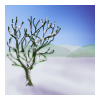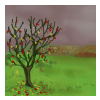The world of Rising Empires is rich and has a lush growth of vegetation. The warm summer is long, and the winter is relatively short. The year is divided in 20 cycles, or months. Each month consists of 1 turn. Each year starts with winter and ends with autumn.

Winter
Winter is five
turns long. It starts with ‘early winter’, continues with three months of regular
winter and ends with ‘late winter’.

Spring
Spring is
short, only two turns. These are ‘early spring’ and ‘spring’.

Summer
Summer is eleven
turns long. It starts with ‘early summer’, continues with nine turns of regular
summer and ends with ‘late summer’.

Autumn
Autumn is,
like spring, no more than two turns long. These are ‘autumn’ followed by ‘late
autumn’.
The current season affects some aspects of the game (details can be found in their respective sections):
Food output – A settlement will not generate any food during the winter season. Food must be stored in order for the citizens to survive through the harsh winter.
Ground combat – There is a large difference between attacking through heaps of snow compared to fighting on dry soil during summer. No sane military leader launches his attacks during winter.
- Winter – Attacker hit chance decrease with 20% and defender hit chance with 10%.
- Spring/Autumn – Attacker hit chance decrease with 10% and defender hit chance with 5%.
- Summer – Attacker hit chance increase with 5%.
Population increase – The birth rate depends on food supply in your settlements. During the colder periods of the year the birth rate in your settlements will be lower than during the warmer periods of the year.
Seasons in the Netherworld
The ecology in the Netherworld is a delicate one. It depends a lot on the climate on the Surface and the circulation of water between the Surface and the Netherworld.
Most of the energy and nutrients that reach the Netherworld comes through the cave openings and the circulation of water between the Surface and Netherworld. During summer this is barely enough for the crops and food for the livestock around the settlements. Another very important mechanism that drives the ecology in the Netherworld is the winter flooding. During the winter large amounts of cold water reach the Netherworld and flood all caves close to any of the rivers. This flooding replenishes much of the soil, allowing for new growth during the summer. The wise men are unsure, but believe the winter flooding depends on the moons and the position of the stars.
This means that the weather and climate on the Surface is reflected in the Netherworld.
